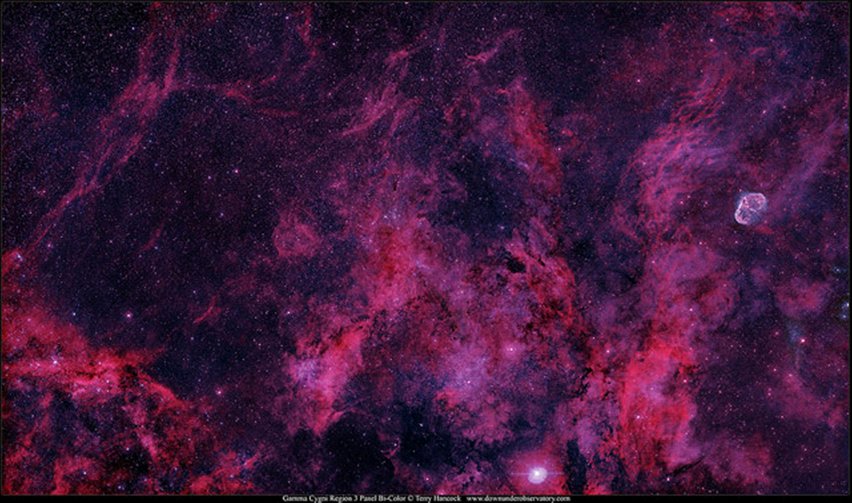

A one-of-a-kind image from Terry Hancock captures the Gamma Cygni region in a different light, not just showing this dynamic star forming region in visible and infrared light, but using a bi-color processing technique.
Specifically, this wide-field view of Gamma Cygni, which is 3-paneled, shows an impressive variety of cosmological features. Most well-known is the Crescent Nebula (or NGC 6888; the cauliflower-shaped structure pictured on the far right), but lesser-known objects include star clusters called NGC 6874 (also on the right) and IC 1311 (near the center), the Propeller Nebula and many patchy dark nebulae.
Of course, one can’t talk about the Gamma Cygni region (otherwise known as IC 1318) without mentioning Sadr; the white-supergiant is the pinnacle of Gamma Cygni and pretty much the constellation of Cygnus as a whole.
As Hancock notes, “Gamma Cygni/Sadr (bottom centre), the namesake star of the constellation of Cygnus the Swan. Very young for a star, a 12 million year old Supergiant and extremely bright. At a distance of 1,800 light-years, this young star easily outshines the vast majority of stars that are very close to the earth. In the study and classification of stars, Gamma Cygni served as an invaluable point of reference in contrast to other stars, allowing early astrophysicists the ability to develop an understanding of stellar evolution and a codified system of classifying all stars.”
He also explained how the image was put together:
Acquired from my amateur backyard observatory in Fremont, Michigan using a QHY11 Monochrome CCD/Takahashi E-180 using narrowband filters and captured over 2 seasons, shown here is a Bi-Color/Hybrid view of The Gamma Cygni Region covering 6.83 x 4.04 degrees of sky, original file size is 6671×3943 pixels, H-Alpaha is mapped to red channel, OIII is mapped to blue and green channels.
Total Integration Time 10.8 hours
See more of Terry’s work here.